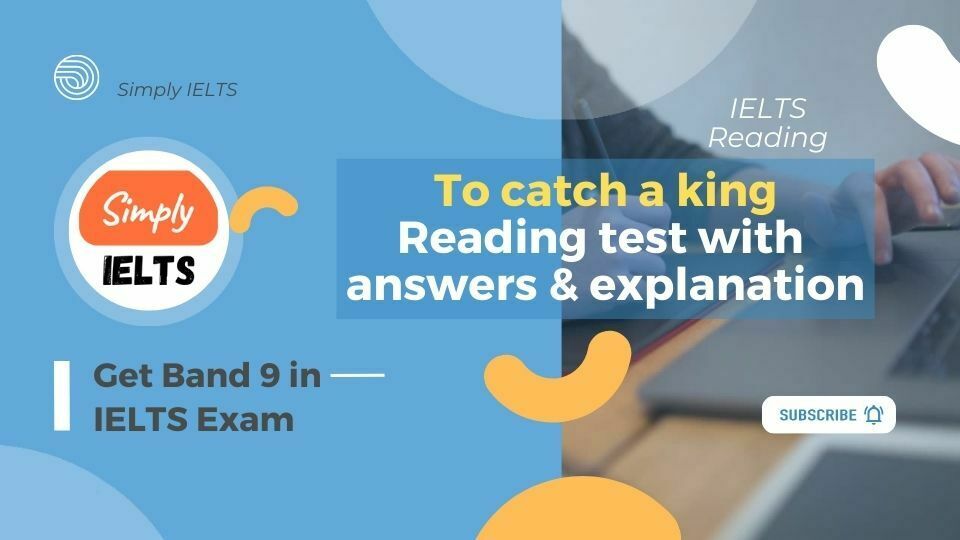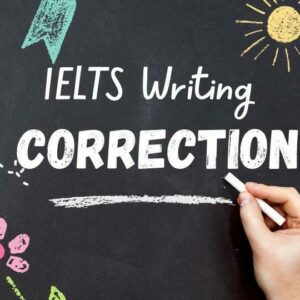To catch a king IELTS reading test with answers and explanation
A new IELTS Reading Academic test passage 3 from Cambridge IELTS 17 Reading test 1 To catch a king IELTS reading test with answers and explanation
In this IELTS Reading exam, you will find To catch a king IELTS reading test with answer keys and explanation

In the Answers tab, you can find To catch a king IELTS reading answers with location and explanation
READING PASSAGE 3
You should spend about 20 minutes on Questions 27-40 which are based on Reading Passage 3 below.
To catch a king
Anna Keay reviews Charles Spencer’s book about the hunt for King Charles II during the English Civil War of the seventeenth century
Charles Spencer’s latest book, To Catch a King, tells us the story of the hunt for King Charles II in the six weeks after his resounding defeat at the Battle of Worcester in September 1651. And what a story it is. After his father was executed by the Parliamentarians in 1649, the young Charles II sacrificed one of the very principles his father had died for and did a deal with Scots, thereby accepting Presbyterianism* as the national religion in return for being crowned King of Scots. His arrival in Edinburgh prompted the English Parliamentary army to invade Scotland in a pre-emptive strike. This was followed by a Scottish invasion of England. The two sides finally faced one another at Worcester in the west of England in 1651. After being comprehensively defeated on the meadows outside the city by the Parliamentarian army, the 21-year-old king found himself the subject of a national manhunt, with a huge sum offered for his capture, through a series of heart-poundingly close escapes, to evade the Parliamentarians before seeking refuge in France. For the next nine years, the penniless and defeated Charles wandered around Europe with only a small group of loyal supporters.
Years later, after his restoration as king, the 50-year-old Charles II requested a meeting with the writer and diarist Samuel Pepys. His intention when asking Pepys to commit his story to paper was to ensure that this most extraordinary episode was never forgotten. Over two three-hour sittings, the king related to him in great detail his personal recollections of the six weeks he had spent as a fugitive. As the king and secretary settled down (a scene that is surely a gift for a future scriptwriter), Charles commenced his story: ‘After the battle was so absolutely lost as to be beyond hope of recovery, I began to think of the best way of saving myself.’
One of the joys of Spencer’s book, a result not least of its use of Charles II’s own narrative as well as those of his supporters, is just how close the reader gets to the action. The day-by-day retelling of the fugitives’ doings provides delicious details: the cutting of the king’s long hair with agricultural shears, the use of walnut leaves to dye his pale skin, and the day Charles spent lying on a branch of the great oak tree in Boscobel Wood as the Parliamentary soldiers scoured the forest floor below. Spencer draws out both the humour – such as the preposterous refusal of Charles’s friend Henry Wilmot to adopt disguise on the grounds that it was beneath his dignity – and the emotional tension when the secret of the king’s presence was cautiously revealed to his supporters.
Charles’s adventures after losing the Battle of Worcester hide the uncomfortable truth that whilst almost everyone in England had been appalled by the execution of his father, they had not welcomed the arrival of his son with the Scots army, but had instead firmly bolted their doors. This was partly because he rode at the head of what looked like a foreign invasion force and partly because, after almost a decade of civil war, people were desperate to avoid it beginning again. This makes it all the more interesting that Charles II himself loved the story so much ever after. As well as retelling it to anyone who would listen, causing eye-rolling among courtiers, he set in train a series of initiatives to memorialise it. There was to be a new order of chivalry, the Knights of the Royal Oak. A series of enormous oil paintings depicting the episode were produced, including a two-metre-wide canvas of Boscobel Wood and a set of six similarly enormous paintings of the king on the run. In 1660, Charles II commissioned the artist John Michael Wright to paint a flying squadron of cherubs* carrying an oak tree to the heavens on the ceiling of his bedchamber. It is hard to imagine many other kings marking the lowest point in their life so enthusiastically, or indeed pulling off such an escape in the first place.
Charles Spencer is the perfect person to pass the story on to a new generation. His pacey, readable prose steers deftly clear of modern idioms and elegantly brings to life the details of the great tale. He has even-handed sympathy for both the fugitive king and the fierce republican regime that hunted him, and he succeeds in his desire to explore far more of the background of the story than previous books on the subject have done. Indeed, the opening third of the book is about how Charles II found himself at Worcester in the first place, which for some will be reason alone to read To Catch a King.
The tantalizing question left, in the end, is that of what it all meant. Would Charles II have been a different king had these six weeks never happened? The days and nights spent in hiding must have affected him in some way. Did the need to assume disguises, to survive on wit and charm alone, to use trickery and subterfuge to escape from tight corners help form him? This is the one area where the book doesn’t quite hit the mark. Instead its depiction of Charles II in his final years as an ineffective, pleasure-loving monarch doesn’t do justice to the man (neither is it accurate), or to the complexity of his character. But this one niggle aside, To Catch a King is an excellent read, and those who come to it knowing little of the famous tale will find they have a treat in store.
————–
* Presbyterianism: part of the reformed Protestant religion
* cherub: an image of angelic children used in paintings
Now start to answer “To catch a king reading test” questions. You will have 20 minutes to answer questions 27 to 40.
.You can download answers as a pdf file from here:
To catch a king IELTS reading test answers and explanation
You can watch the video or find the solution in the answers tab at the top of this article
To catch a king IELTS reading test Questions
click Finish exam to check the correct answers
To catch a king IELTS Reading answers with location and explanation
| Questions | Answers |
|---|---|
| 27 | H |
| 28 | J |
| 29 | F |
| 30 | B |
| 31 | D |
| 32 | NOT GIVEN |
| 33 | NO |
| 34 | NO |
| 35 | YES |
| 36 | B |
| 37 | C |
| 38 | A |
| 39 | B |
| 40 | D |
To Catch a king IELTS Reading answers with explanations
Question 27 Explanation
Question: Charles II’s father was executed by the Parliamentarian forces in 1649. Charles II then formed a 27…………… with the Scots,
Answer Location: After his father was executed by the Parliamentarians in 1649, the young Charles II sacrificed one of the very principles his father had died for and did a deal with the Scots, thereby accepting Presbyterianism* as the national religion in return for being crowned King of Scots.
Key words:
- Charles II
- Parliamentarian
- Formed
- Scots
Comparing the question with the passage, we have:
- Based on the keywords, we need to find a noun for a thing/something that King Charles II formed with the Scots. Through the passage, we see that King Charles made an agreement with the Scots by accepting Presbyterianism as the state religion on the condition that he became king.
- The agreement is strategic because both parties benefit, so the right word to fill in is H – strategic alliance.
Correct Answer: H – strategic alliance.
Question 28 Explanation
Question: And in order to become King of Scots, he abandoned an important 28……………….. that was held by his father and had contributed to his father’s death.
Answer Location: After his father was executed by the Parliamentarians in 1649, the young Charles II sacrificed one of the very principles his father had died for and did a deal with the Scots, thereby accepting Presbyterianism* as the national religion in return for being crowned King of Scots.
Key words:
- Abandoned => sacrifice
- Contributed to his father’s death => his father died for
Comparing the question with the passage, we have:
- Looking at the keyword, we see a blank need a word for something that King Charles II gave up and this is also what led to his father’s death. In the passage above, we see him sacrificing a rule that caused his father’s death by adopting Presbyterianism as the state religion.
- In other words, King Charles II gave up a religious belief, so J – religious conviction is the right word to fill in.
Correct Answer: J – religious conviction
Question 29 Explanation
Question: The opposing sides then met outside Worcester in 1651. The battle led to a 29…………….. for the Parliamentarians and Charles had to flee for his life.
Answer Location: The two sides finally faced one another at Worcester in the west of England in 1651. After being comprehensively defeated on the meadows outside the city by the Parliamentarian army, the 21-year-old king found himself the subject of a national manhunt, with a huge sum offered for his capture. Over the following six weeks he managed, through a series of heart-poundingly close escapes, to evade the Parliamentarians before seeking refuge in France. For the next nine years, the penniless and defeated Charles wandered around Europe
Key words:
- Battle
- For the Parliamentarians
- flee
Comparing the question with the passage, we have:
- The keyword shown blank is a noun indicating something for Parliamentarians from the battle of Worcester.
- According to the information in the reading passage, this is a battle where King Charles II was completely defeated and he had to flee, which means that this is a victory for the Parliamentarians.
- So F – decisive victory is the right word to fill in.
Correct Answer: F – decisive victory
Question 30 Explanation
Question: A 30…………… was offered for Charles’s capture,
Answer Location: After being comprehensively defeated on the meadows outside the city by the Parliamentarian army, the 21-year-old king found himself the subject of a national manhunt, with a huge sum offered for his capture.
Key words:
- Offered
- Charles’s capture
Comparing the question with the passage, we have:
- Based on the keyword we need a noun for something suggested for the capture of King Charles.
- In the above paragraph, we see information that a large amount of money was offered for the arrest of King Charles.
- Compared with the options, B – large reward is the answer that fits this information.
Correct Answer: B – large reward
Question 31 Explanation
Question: But after six weeks spent in hiding, he eventually managed to reach the 31………….. of continental Europe
Answer Location: Over the following six weeks he managed, through a series of heart-poundingly close escapes, to evade the Parliamentarians before seeking refuge in France.
Key words:
- Six weeks
- Hiding => evade
- Continental Europe => France
Comparing the question with the passage, we have:
- According to the keyword “six weeks”, we can identify information related to the occurrence after “six weeks” and that is King Charles’ asylum in France.
- So the vacancy has to do with his arrival as a refugee in France.
- Of the options, only D – relative safety is appropriate because it shows that King Charles is relatively safe in mainland Europe (specifically in France).
Correct Answer: D – relative safety
Question 32 Explanation
Question: Charles chose Pepys for the task because he considered him to be trustworthy (Yes/No/Not Given)
Answer Location: Years later, after his restoration as king, the 50-year-old Charles II requested a meeting with the writer and diarist Samuel Pepys. His intention when asking Pepys to commit his story to paper was to ensure that this most extraordinary episode was never forgotten.
Key words:
- Charles
- Pepys
- trustworthy
Comparing the question with the passage, we have:
- With keywords, we find this information related to the reason the king chose Pepys for the story.
- However, the article only states that the king wanted to put the story on paper because he did not want his story to be forgotten, but did not mention why he chose Pepys.
Correct Answer: Not Given
Question 33 Explanation
Question: Charles’s personal recollection of the escape lacked sufficient detail.
Answer Location: Over two three-hour sittings, the king related to him in great detail his personal recollections of the six weeks he had spent as a fugitive. As the king and secretary settled down (a scene that is surely a gift for a future scriptwriter), Charles commenced his story: “After the battle was so absolutely lost as to be beyond hope of recovery, I began to think of the best way of saving myself.”
Key words:
- Recollection of the escape
- Lacked
- Sufficient detail
Comparing the question with the passage, we have:
- The content of the question stated that the king’s personal recollections lacked complete information.
- However, according to the information above, the king recounted in detail his personal recollection of 6 weeks on the run, in stark contrast to the information in the question.
Correct Answer: No
Question 34 Explanation
Question: Charles indicated to Pepys that he had planned his escape before the battle.
Answer Location: As the king and secretary settled down (a scene that is surely a gift for a future scriptwriter), Charles commenced his story: “After the battle was so absolutely lost as to be beyond hope of recovery, I began to think of the best way of saving myself.”
Key words:
- Indicated
- Had planned his escape
- Before the battle
Comparing the question with the passage, we have:
- The information in question suggested that the king planned to escape before the battle.
- However, according to the information in the above paragraph, the king said that he started thinking about saving his life after losing the battle, which is exactly the opposite of the question so the answer is NO.
Correct Answer: No
Question 35 Explanation
Question: The inclusion of Charles’s account is a positive aspect of the book.
Answer Location: One of the joys of Spencer’s book, a result not least of its use of Charles II’s own narrative as well as those of his supporters, is just how close the reader gets to the action. The day-by-day retelling of the fugitive’s doings provides delicious details: the cutting of the king’s long hair with agricultural shears, the use of walnut leaves to dye his pale skin, and the day Charles spent lying on a branch of the great oak tree is Boscobel Wood as the Parliamentary soldiers scoured the forest floor below
Key words:
- Inclusion
- Charles’s account
- Positive
Comparing the question with the passage, we have:
- The information in the sentence shows that accompanying Charles’ story is a positive part of the book.
- According to the information in the article, one of the fun things from the book is the use of the story of the king and his supporters.
- These two information have the same meaning, so the answer is YES.
Correct Answer: Yes
Question 36 Explanation
Question:
What is the reviewer’s main purpose in the first paragraph?
A. to describe what happened during the Battle of Worcester
B. to give an account of the circumstances leading the Charles II’s escape
C. to provide details of the Parliamentarians’ political views
D. to compare Charles II’s belief with those of his father
Answer Location: Charles Spencer’s latest book, To Catch a King, tell us the story of the hunt for King Charles II in the six weeks after his resounding defeat at the Battle of Worcester in September 1651. And what a story it is. After his father was executed by the Parliamentarians in 1649, the young Charles II sacrificed one of the very principles his father had died for and did a deal with the Scots, thereby accepting Presbyterianism* as the national religion in return for being crowned King of Scots.
Key words:
- Main purpose
- First paragraph
Comparing the question with the passage, we have:
- In the first paragraph, the writer introduces the name of the book and begins to introduce the story of King Charles.
- In it, the author talks about the events that took place before King Charles fled (father was executed, the battle of Worcester, King Charles lost the battle and had to flee to France).
- We see that these are information describing the situation before the king fled and option B shows the same meaning, so it is the correct option.
Correct Answer: B
Question 37 Explanation
Question:
Why does the reviewer include examples of the fugitives’ behaviours in the third paragraph?
A. to explain how close Charles II came to losing his life
B. to suggest that Charles II’s supporter were badly prepared
C. to illustrate how the events of the six weeks are brought to life
D. to argue that certain aspects are not as well known as they should be
Answer Location: The day-by-day retelling of the fugitive’s doings provides delicious details: the cutting of the king’s long hair with agricultural shears, the use of walnut leaves to dye his pale skin, and the day Charles spent lying on a branch of the great oak tree is Boscobel Wood as the Parliamentary soldiers scoured the forest floor below.
Key words:
- Include
- Fugitives’ behaviors
Comparing the question with the passage, we have:
- The question asks about the purpose of telling the fugitives’ activities.
- Option A is incorrect because these activities do not involve their life being endangered.
- Information B and D are not shown in this paragraph. So only C is the correct answer.
Correct Answer: C
Question 38 Explanation
Question:
What point does the reviewer make about Charles II in the fourth paragraph?
A. He chose to celebrate what was essentially a defeat.
B. He misunderstood the motives of his opponents.
C. He aimed to restore people’s faith in the monarchy.
D. He was driven by a desire to be popular
Answer Location: This was partly because he rode at the head of what looked like a foreign invasion force and partly because, after almost a decade of civil war, people were desperate to avoid it beginning again. This makes it all the more interesting that Charles II himself loved the story so much ever after. As well as retelling it to anyone who would listen, causing eye-rolling among courtiers, he set in train a series of initiatives to memorialise it.
Key words:
- Charles II
- Fourth paragraph
Comparing the question with the passage, we have:
- In paragraph 4, we see information that he likes the story of his defeat at the battle of Worcester and tells it to anyone who wants to hear it.
- In addition, he also launched a series of initiatives to commemorate it, like to celebrate a victory.
- Sentence A shows the same meaning that he chose to celebrate an event that is considered a failure, so it is the correct answer.
Correct Answer: A
Question 39 Explanation
Question:
What does the reviewer say about Charles Spencer in the fifth paragraph?
A. His decision to write the book comes as a surprise.
B. He takes an unbiased approach to the subject matter.
C. His descriptions of events would be better if they included more detail.
D. He chooses language that is suitable for a twenty-first-century audience.
Answer Location: Charles Spencer is the perfect person to pass the story on to a new generation. His pacy, readable prose steers deftly clear of modern idioms and elegantly brings to life the details of the great tale. He has even-handed sympathy for both the fugitive king and the fierce republican regime that hunted, and he succeeds in his desire to explore far more of the background of the story that previous books on the subject have done. Indeed, the opening third of the book is about how Charles II found himself at Worcester in the first place, which for some will be reason alone to read To Catch a King.
Key words:
- Charles Spencer
- Fifth paragraph
Comparing the question with the passage, we have:
- In paragraph 5 we see information that the author Charles Spencer has sympathy for both sides, the king and the side that hunts him, which means that he has an unbiased approach with this topic.
- Option B expresses this idea correctly, so it is the correct option.
Correct Answer: B
Question 40 Explanation
Question:
When the reviewer says the book ‘doesn’t quite hit the mark’, she is making the point that
A. it overlooks the impact of events on ordinary people.
B. it lacks an analysis of prevalent views on monarchy.
C. it omits any references to the deceit practiced by Charles II during his time in hiding.
D. it fails to address whether Charles II’s experiences had a lasting influence on him
Answer Location: The tantalizing question left, in the end, is that of what it all meant. Would Charles II have been a different king had these six weeks never happened? The days and nights spent in hiding must have affected him in some way. Did the need to assume disguises, to survive on wit and charm alone, to use trickery and subterfuge to escape from tight corners help form him? This is one area where the book doesn’t quite hit the mark. Instead its depiction of Charles II in his final years as an ineffective, pleasure-loving monarch doesn’t do justice to the man (neither is it accurate),
Key words:
- Doesn’t quite hit the mark
Comparing the question with the passage, we have:
- Before writing the sentence “it doesn’t quite hit the mark”, the writer mentioned questions about what happened 6 weeks after the event of King Charles II that was not mentioned in the book, namely: the effects of this event on King Charles.
- This shows that the book does not account for the effects of these six weeks on King Charles and this makes the author feel the book is incomplete.
- Option D is appropriate because it conveys the same meaning as the above information.
Correct Answer: D





No
Great
[email protected]